With our wealth of knowledge gained from years of building healthy teams, we're excited to give back to the community. We hope you find the following tools, tips, and templates helpful as you grow your leaders and improve the health of your organization.
Resilient Management
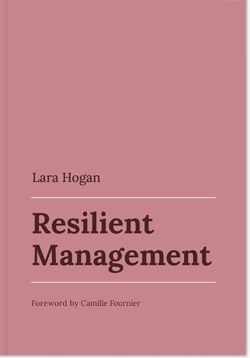
Finding your bearings as a manager can feel overwhelming—but you don’t have to fake it to make it, and you don’t have to go it alone.
Lara Hogan, co-founder of Wherewithall, shares her recipe for supporting and leading a tech team—from developing your mentoring and coaching skills, to getting comfortable with having difficult conversations, to boosting trust among teammates—while staying grounded along the way.
Whether your title is “lead”, “manager”, or something else: if you’re responsible for supporting and leading a team of people, this book is for you.
Purchase
Resources for New Managers

We developed Resources for New Managers to serve as a library of foundational resources for new and emerging leaders to read, watch, and bookmark for when they need it.
Organized by learning style, you’ll find tools, articles, videos, podcasts, worksheets, and more, all by Wherewithall.
See all resources
One-on-One Tools

Questions for your First One-on-One
Lara has had the pleasure of kicking off lots of new reporting relationships with both engineers and engineering managers. Over time, she’s learned that getting some particular data during an initial 1:1 can be really helpful, as she can refer back to the answers as she needs to give a person feedback, recognize them, and find creative ways to support them. Use this list of questions to strengthen your own reporting relationships!
Get this free tool
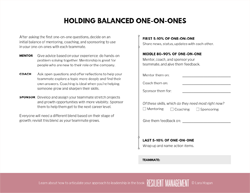
Holding Balanced One-on-Ones
After asking the first one-on-one questions, decide on an initial balance of mentoring, coaching, and sponsoring to use in your one-on-ones with each teammate. Use this worksheet to help you game plan each one-on-one! Everyone will need a different blend based on their stage of growth; revisit this blend as your teammate grows.
Get this free tool
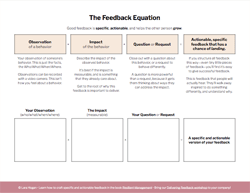
Feedback Equation worksheet
Use this worksheet to transform any feedback you need to deliver into something that your teammate will be able to hear, understand, and take immediate action on.
Get this free tool
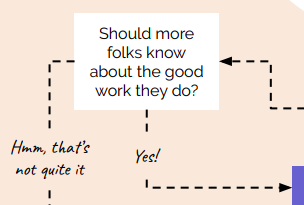
How to Help Flowchart
We tend to default to advice-giving when someone on our team needs a hand. Instead, consult this flow chart to help you decide when to use mentoring mode, or two other important modes: coaching, and sponsoring.
Get this free tool
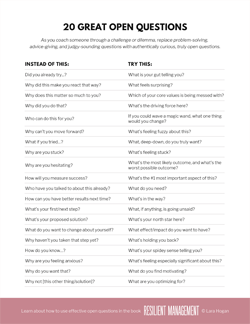
20 Great Open Questions
You already know that when you’re helping someone overcome a challenge, you should ask lots of open questions. Unfortunately, questions that start with “why” tend to make the other person feel judged, and questions that start with “how” tend to go into problem solving mode—both of which we want to avoid.
As you coach someone through a challenge or dilemma, replace problem-solving, advice-giving, and judgy-sounding questions with these authentically curious, truly open questions.
Get this free tool
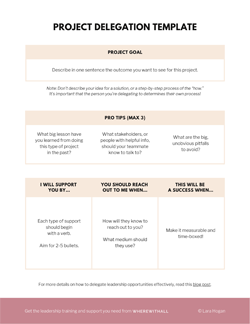
Project Delegation Template
The best gift you can give your teammates is a stretch leadership project with a bit of a safety net. This creates the most impactful opportunity for someone to grow their skills, support network, and visibility. As scary as it might feel, delegating big pieces of work is crucial to build your leadership bench!
Use this template to set your teammate up for success—and protect your own time and energy—as you entrust them with this work.
Get this free tool
Team Dynamics Tools
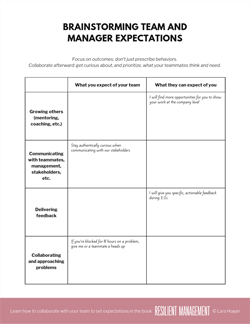
Setting Expectations worksheet
One simple way to create predictability and stability for your team is to be transparent about what you expect of your teammates, and what they can expect of you.
Use this worksheet to brainstorm and collaborate with your teammates on team norms around feedback, supporting each other, communicating, and collaborating.
Get this free tool
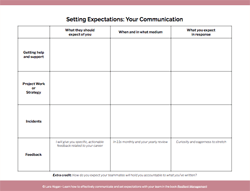
Setting Communications Expectations worksheet
When do you expect your reports will ask you for help, or support? How do you expect them to respond to incidents? How should they expect you will respond when they give you feedback?
Use this worksheet to build upon the setting expectations worksheet. Get even more specific about the medium and cadence of your team’s communication, and establish norms around how others will respond.
Get this free tool
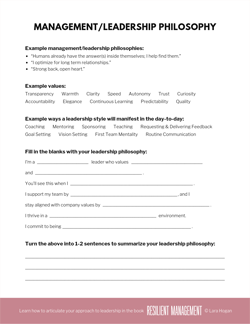
Management/Leadership Philosophy worksheet
A philosophy crystallizes in one sentence (which is helpful for others) what kind of manager you are. It translates those expectations you have for your direct reports and what they should expect of you into something digestible and shareable. Use this worksheet to articulate your own approach to management or leadership.
Get this free tool
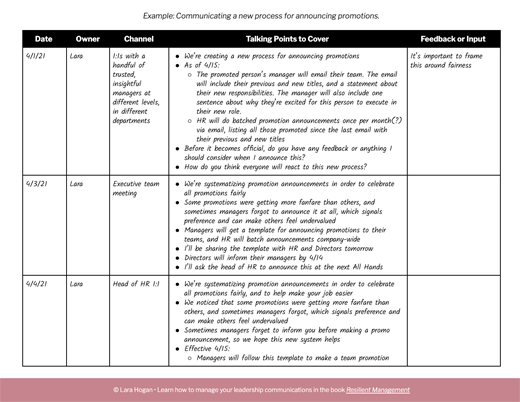
Tick Tock Doc Template
As a leader, you shouldn’t YOLO big announcements. Create a plan in partnership with others communicating this news, or those who will deal with the ripple effects of these changes. This way, you can hone the messaging and the timing together.
Informing your broader team will go much more smoothly if you’re prepared and have a plan. Use this template to reduce surprise, partner with other communicators on key messages, catch potential pitfalls, and address potential questions.
Get this free tool
Tools for Building Resiliency
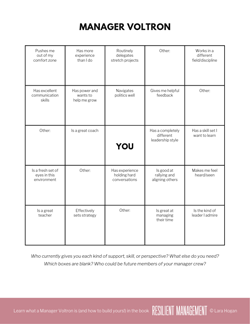
Manager Voltron worksheet
In our Mentoring, Coaching, and Sponsoring workshop, we describe assembling a diverse, supportive crew of people (a “Manager Voltron”) whom you can lean on as you grow. Each can provide a different facet of what your ideal manager would be!
Use this worksheet to help you brainstorm who could be a part of your crew, see where you’ve got blanks, and get to work building out your support network.
Get this free tool
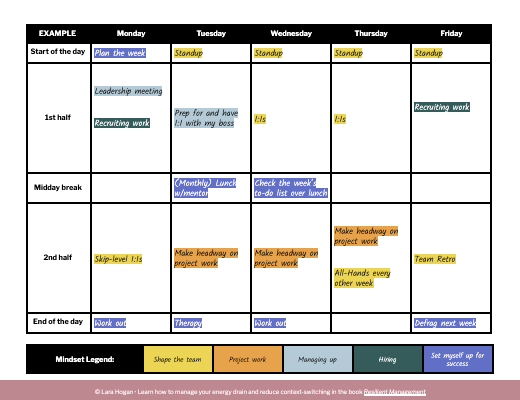
Defrag your Calendar worksheet
You may find yourself working long hours to do hands-on “work-work” after full days of one-on-ones; orthat the labor of managing or more strategic thinking drains your energy significantly faster than the work you did as an individual contributor. Or you may find the context-switching between meetings super taxing. Or perhaps all of the above.
In Lara Hogan’s Manager Energy Drain blog post, she describes color-coding your calendar based on the kind of thinking you’re doing in each meeting, then “defragging” to help reduce context-switching and undo blocks of energy-draining meetings. Use this worksheet to help you defrag!
Get this free tool
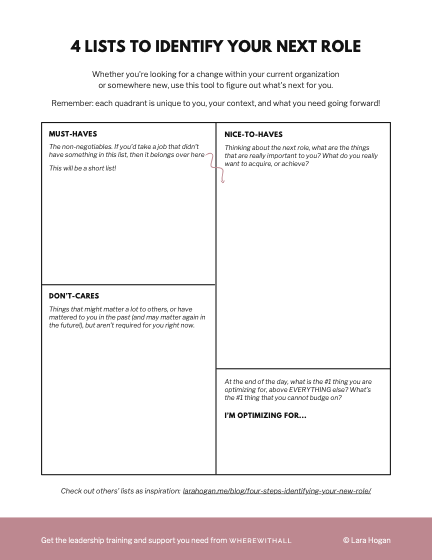
4 Lists to Identify Your Next Role
What do you want in your next role? How can you make sure you find the right place? Where do you even start?
When I coach those who are considering job and role changes, I ask them to answer the four prompts on this worksheet.
Whether you’re looking for a change within your current organization or somewhere new, use this tool to figure out what’s next for you.
Get this free tool
People Process Tools
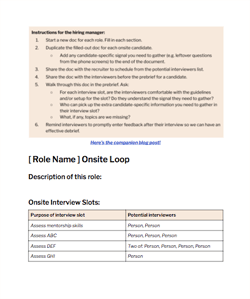
Onsite Interview Loop Template
When hiring, it’s important to build a consistent, repeatable, and inclusive interview process that yields strong signals on candidates. By using this template, a hiring manager can hone in on what signals they need from the interview process, and better-ensure that a candidate isn’t receiving duplicate or unnecessary questions from interviewers.
After the hiring manager fills out this template, interviewers will have an easier time deciding how to approach their interview slot, and they can gain a better sense of what tried-and-true methods will be inclusive and yield good signal.
Get this free tool

Tracking compensation and promotion inequity
An organization won’t find much success recruiting a more diverse group of employees unless its leaders are aware of their existing internal inclusion and equity issues. Use this worksheet as a template to follow when you calculate compensation and promotion rate fairness within your organization.
Get this free tool

Revamp a Meeting worksheet
Choose a recurring meeting with 6+ attendees that you own, or you attend and are invested in. Use this worksheet to figure out which aspects of the agenda could be turned into asynchronous activities, instead of working through them in the meeting. Create a new agenda by assigning a driver to each item, allocating time to it, and deciding which work could be done before the meeting or after the meeting to make sure the agenda item is effective.
Get this free tool

















